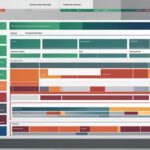Table of Contents
Web accessibility is crucial in the digital world, but less than 2% of the top million websites are fully accessible. This creates substantial barriers for disabled users, preventing them from enjoying the full website experience.
Web accessibility ensures easy access to information for people with disabilities, and it is estimated that 15% of the world’s population has some form of disability. Having an accessible website not only reaches a larger audience but also aligns with ethical and legal requirements, such as the Americans with Disabilities Act (ADA).
Integrating accessibility measures into web development is essential for creating inclusive and user-friendly websites.
When it comes to web accessibility, the goal is to create fully accessible websites that provide a seamless experience for all users, regardless of their abilities. By addressing common accessibility barriers, web developers can ensure that their websites are accessible to everyone and comply with web accessibility guidelines.
Throughout this article, we will explore various accessibility barriers in web development and discuss effective strategies to overcome them, enabling you to create fully accessible websites that reach a wider audience.
Let’s dive into the world of web accessibility and discover how to make your websites fully inclusive!
Understand Website Accessibility Issues
Website accessibility issues refer to barriers that hinder people with disabilities from accessing and interacting with websites. These barriers can prevent disabled users from fully experiencing the content and functionality of a website, creating a frustrating and exclusionary browsing experience.
Different disabilities have specific effects on web browsing, highlighting the need for accessible technology and design. For example, individuals with physical impairments often rely on keyboard-only navigation to navigate web pages effectively. On the other hand, individuals who are blind or visually impaired depend on screen readers to interpret and vocalize website content.
Failing to address website accessibility issues and comply with established guidelines, such as the Web Content Accessibility Guidelines (WCAG), can have legal repercussions. Non-compliant websites risk excluding a significant portion of the user base and potentially face litigation.
Implementing web accessibility measures is crucial to ensure that websites reach their intended audience and provide equal access to information and services. By considering the diverse needs of disabled users, web developers can create inclusive digital spaces that enhance user experience and brand image.
| Common Website Accessibility Issues | Effects on Disabled Users |
|---|---|
| 1. Inaccessible navigation | – Difficulty in navigating the website using alternative input methods, such as keyboard-only navigation for individuals with physical impairments |
| 2. Lack of alternative text for images | – Screen reader users cannot access the information conveyed by visual content |
| 3. Poor color contrast | – Visually impaired users may struggle to read or distinguish elements due to insufficient contrast between text and background colors |
| 4. Complex forms | – Difficulties in completing forms for users with cognitive or physical impairments, as well as limited support for assistive technologies |
| 5. Missing or ambiguous link text | – Navigation challenges for screen reader users, who rely on link text to understand the purpose and destination of hyperlinks |
| 6. Inconsistent heading structure | – Difficulties in understanding and navigating website content for users who rely on screen readers and require a logical heading structure |
By addressing these website accessibility issues, developers can enhance the user experience for disabled individuals, make their content more widely available, and align with legal requirements and ethical standards.
The Conjunction is Missing or Ambiguous
One common issue found on many websites is the presence of missing or ambiguous link text. This can lead to confusion for users, especially those who rely on screen readers to navigate and interact with web content. It is crucial to ensure that link text clearly describes the purpose or function of the linked page, as screen readers read linked text without the surrounding context.
Instead of using generic phrases like “Click Here” or “Learn More,” it is important to use descriptive link text that provides users with a clear understanding of where the link will take them. By using relevant and informative link text, web developers can enhance the accessibility and usability of their websites for all users, including those with disabilities.
In addition to descriptive link text, providing alt text for linked images is another important accessibility consideration. Alt text, or alternative text, is used to describe the content or purpose of an image. It plays a crucial role in making visual content accessible to screen reader users, as it allows them to understand the meaning or context of the image.
Screen reader navigation heavily relies on clear and descriptive link text, as well as informative alt text for linked images. By addressing the issue of missing or ambiguous conjunctions, web developers can create a more inclusive and user-friendly web experience for all users.
Benefits of Clear Link Text:
- Improves screen reader navigation
- Enhances usability for all users
- Reduces confusion and frustration
- Aligns with web accessibility guidelines
Good Background and Different Text Colors
Color contrast plays a crucial role in web design, especially for users with visual impairments, including color-blind individuals. It significantly impacts text legibility and the overall user experience. Low color contrast can make it challenging for color-blind users to read and navigate web content effectively, hindering their ability to fully engage with the website.
To ensure accessibility for all users, it is essential to follow the Web Content Accessibility Guidelines (WCAG) standards. WCAG recommends specific contrast ratios between text and background colors to enhance readability and usability. By adhering to these guidelines, web developers can create fully accessible websites that consider the needs of color-blind users and provide an inclusive browsing experience for all visitors.
To ensure that the color contrast on your website meets WCAG standards, you can use helpful tools like color contrast checkers. These tools analyze the color contrast between text and background elements and provide feedback on whether they meet the recommended contrast ratios. By utilizing these tools, you can make necessary adjustments to the color scheme of your website to improve its accessibility.
Why is color contrast important?
“Color contrast is essential for users with color vision deficiencies. It ensures that text is legible and distinguishable from the background, allowing individuals with visual impairments to access and comprehend web content effectively.” – Dr. Emily Lewis, Web Accessibility Expert
High color contrast enables users with color vision deficiencies to differentiate between text and background, enhancing the clarity and readability of the content. By considering the needs of color-blind users, web designers can create accessible websites that accommodate a diverse range of users and provide an optimal user experience for all visitors.
Improving color contrast for better accessibility
There are several ways to enhance color contrast on your website:
- Choose high-contrast color combinations: Select color combinations that provide sufficient contrast between text and background. For example, using dark text on a light background or light text on a dark background can improve readability.
- Test your color choices: Use color contrast checkers to evaluate the contrast ratios of your color combinations. These tools will help you identify areas where the contrast may be insufficient and suggest alternative color options.
- Pay attention to text overlay on images: When overlaying text on images, ensure that the contrast between the text and the image background is adequate for readability. Adjust the colors as necessary to improve legibility.
By focusing on color contrast, web developers can create websites that are accessible and inclusive for all users, including those with visual impairments. Prioritizing text legibility through appropriate color choices helps to ensure that every visitor can engage with the content effectively.
| WCAG Contrast Ratio | Text Size | Minimum Contrast Ratio |
|---|---|---|
| Normal Text | Large (>=18pt or >=14pt + bold) | 3:1 |
| Regular (>=12pt and | 4.5:1 | |
| Small ( | 4.5:1 | |
| Large Text | Large (>=18pt or >=14pt + bold) | 3:1 |
| Regular (>=12pt and | 3:1 | |
| Small ( | 3:1 |
Ensuring proper color contrast is not only a matter of accessibility but also contributes to the overall aesthetics and professionalism of a website. By implementing good background and text colors, web developers can create visually appealing and user-friendly websites that accommodate the needs of a diverse range of users.
Incorporating accessible design principles
Color contrast is just one aspect of web accessibility. To create fully accessible websites, web developers should consider incorporating other design principles, such as:
- Using clear and concise language
- Providing alternative text for images
- Implementing keyboard navigation
- Ensuring proper HTML structure
By following these principles, web developers can foster inclusivity and provide a seamless browsing experience for all users, regardless of their abilities or disabilities.
Inaccessible Forms
Many online forms suffer from a common accessibility issue – blank form tags. These tags fail to provide control information to assistive technology, such as screen readers, creating a significant barrier for disabled users who rely on such technology to navigate and complete forms. To ensure inclusivity and accessibility, web developers should implement several measures.
Firstly, it is crucial to provide clear labels for input fields. Clear and descriptive labels inform users about the purpose of each input field, enabling them to easily complete the form. Additionally, developers should ensure that form elements are properly coded using accessible HTML tags, such as the <label> tag. By doing so, it becomes easier for assistive technology to associate labels with their respective input fields, enhancing the overall accessibility of the form.
Furthermore, including descriptive text for buttons and CAPTCHA (Completely Automated Public Turing test to tell Computers and Humans Apart) improves form usability for all users. Descriptive button text offers clear instructions for users, facilitating the completion of the form. Meanwhile, descriptive CAPTCHA instructions help users understand and pass the security measure without any confusion.
Example of an Inaccessible Form:
| Field | Type | Description |
|---|---|---|
| Text | Enter your name | |
| Enter your email address | ||
| Button | Click here to submit the form |
Example of an Accessible Form:
| Field | Type | Description |
|---|---|---|
| Enter your name | ||
| Enter your email address | ||
| Button | Click here to submit the form |
By following these best practices, web developers can create accessible forms that provide a smooth user experience for all individuals, including those with disabilities who depend on assistive technology.
Replace the missing text or missing information in the images
Many web pages have images without appropriate alt text, making them inaccessible to screen reader users. Alt text describes the content or purpose of the image and is essential for screen reader users to understand the meaning or context of visual content. Including alt text that is brief, descriptive, and relevant helps users with visual impairments comprehend the content of images. Decorative images can be excluded from alt text to avoid unnecessary information overload.
When adding an image to your website, it is important to include the alt attribute in the img tag. This attribute allows you to provide a short description or alternative text for the image. Screen readers will then read this alt text aloud to users with visual impairments, ensuring they have access to the same information as sighted users.
“The alt text should provide the same information or convey the same function as the image itself.” – Web Content Accessibility Guidelines (WCAG)
By replacing missing alt text or adding proper descriptions to images, you enhance the visual content accessibility of your website and improve screen reader comprehension. This enables all users, regardless of their visual abilities, to fully engage with your website’s visual elements and understand their purpose or context.
Example:
| Image | Alt Text |
|---|---|
| Example of an image without proper alt text |
In the example above, the image is missing the necessary alt text. This would make it difficult for screen reader users to understand the content or purpose of the image. By adding appropriate alt text, such as “Example of an image without proper alt text,” you would ensure that screen reader users can comprehend the visual content.
Incorrect HTML content structure
The proper HTML content structure is crucial for screen reader navigation and comprehension. By using the correct heading tags in the right order and organizing content with headings, web developers can enhance the accessibility of their websites. This ensures that screen readers can easily identify the structure of the page and provide a seamless browsing experience for individuals with visual impairments.
Using bold text or other improper heading structures instead of proper headings can confuse screen reader users and negatively impact the SEO of the website. Therefore, it is essential to follow HTML best practices and adhere to proper content structuring techniques.
Here are some tips to improve HTML structure for better screen reader navigation and SEO impact:
- Use heading tags (
<h1>,<h2>, etc.) to create a logical hierarchy of headings to outline the content. This helps screen readers understand the organization of the page. - Avoid skipping heading levels or using them out of order. This can cause confusion for screen readers and make it difficult for users to navigate through the content.
- Ensure the headings accurately describe the content that follows. Clear and descriptive headings help screen reader users quickly find the information they need.
- Use proper HTML markup for lists, paragraphs, and other content elements. This helps screen readers interpret the content correctly and present it to users in a structured manner.
- Consider using landmark roles, such as
<nav>for navigation menus and<main>for the main content area. This provides additional navigation cues for screen reader users. - Regularly test the website with screen readers to ensure proper navigation and comprehension.
Following these guidelines for HTML content structure not only improves accessibility for screen reader users but also has a positive impact on the overall SEO of the website. By creating a well-structured HTML document, web developers can provide a better user experience for all visitors.
Conclusion
Creating accessible websites involves adhering to web accessibility principles and guidelines, such as those outlined in the Web Content Accessibility Guidelines (WCAG). By implementing best practices, such as providing alternative content, ensuring clear and consistent layout and navigation, adjusting color and contrast, enabling keyboard and touch input, and regularly testing for accessibility, web developers can significantly enhance user experience.
Overcoming accessibility barriers is crucial for creating user-friendly websites that reach a wider audience and strengthen brand image. Web accessibility is not just about compliance; it is about creating an inclusive digital space for everyone. By embracing inclusive design, web developers can ensure that their websites cater to the needs of individuals with disabilities, ultimately providing a positive and inclusive online experience.
Remember, incorporating web accessibility principles and inclusive design is not only ethically responsible but also essential for meeting legal requirements and fulfilling the growing demand for inclusive and user-friendly websites. By prioritizing web accessibility, developers can make a meaningful impact, foster inclusivity, and contribute to a more accessible and inclusive digital landscape.
FAQ
What are some common accessibility barriers in web development?
Common accessibility barriers in web development include missing or ambiguous link text, low color contrast, blank form tags, missing alt text in images, and improper HTML content structure.
What are website accessibility issues?
Website accessibility issues refer to barriers that prevent people with disabilities from accessing and interacting with websites. These barriers can include difficulties with navigation, reading content, completing forms, and understanding images.
How can missing or ambiguous link text affect accessibility?
Missing or ambiguous link text can cause confusion for users who rely on screen readers. Clear and descriptive link text is crucial for screen reader users to understand the purpose or function of the linked page.
Why is color contrast important for web design?
Color contrast is crucial for users with visual impairments, especially those who are color-blind. Proper color contrast ensures that all users can read and navigate web content effectively.
What are blank form tags and why are they a problem?
Blank form tags refer to form elements that do not provide control information to assistive technology like screen readers. This creates a barrier for disabled users who rely on assistive technology to navigate and complete forms.
Why is alt text essential for images?
Alt text describes the content or purpose of images, allowing screen reader users to understand the meaning or context of visual content. Including alt text ensures that images are accessible to users with visual impairments.
How does the HTML content structure impact accessibility?
Proper HTML content structure is crucial for screen reader users to navigate and comprehend web pages effectively. Using correct heading tags and organizing content with headings makes it easier for screen readers to identify the structure of the page.
What are some web accessibility principles for creating user-friendly websites?
Web accessibility principles include providing alternative content, ensuring clear and consistent layout and navigation, adjusting color and contrast, enabling keyboard and touch input, and regularly testing and evaluating websites for accessibility.













